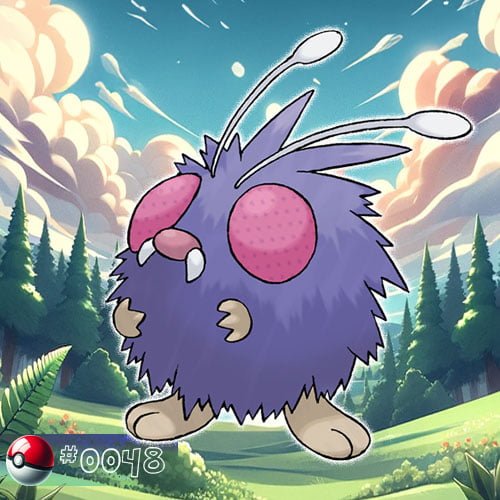Venomoth
Venomoth is a nocturnal Pokémon that uses its wings to scatter toxic dust and confuse its opponents. In battle, it can be a formidable adversary, utilizing its unique combination of Bug and Poison type moves.
Biology
Physical Characteristics
Venomoth is a Pokémon with distinctive physical characteristics.
Venomoth’s body is segmented, resembling that of an insect. It has a distinct head, thorax, and abdomen. The main body color is purple, with its wings being green. The shades create a visually striking appearance.
The wings of Venomoth are broad and delicate, allowing for agile flight. They have intricate eye-like patterns, possibly serving a defensive purpose or for intimidating foes. The thorax and abdomen are well-defined, showcasing the typical anatomy of an insect. The segments contribute to its flexibility.
Venomoth’s long antennae are sensory organs that aid in detecting its surroundings. They add to its insectoid features and may play a role in communication.
Its large red compound eyes are adapted for low-light conditions, indicating a preference for nighttime activity. The scales on its wings contain a special powder. This powder can have various effects, such as inducing sleep or poisoning opponents. It’s a unique defensive mechanism.
While Venomoth doesn’t have visible legs, it likely possesses six jointed legs typical of insects, contributing to its agility.
These detailed characteristics collectively define Venomoth’s unique and adaptable physical traits within the Pokémon world.
Behaviour
Venomoth, like many Pokémon, exhibits a range of behaviors influenced by its environment, instincts, and interactions. Here are details about Venomoth’s behavior.
Venomoth is primarily nocturnal, being more active during the night. Its large red compound eyes suggest adaptation to low-light conditions. Venomoth is an adept flier, utilizing its broad wings for agile movements. It can swiftly navigate through the air, making it difficult for opponents to catch.
The eye-like patterns on Venomoth’s wings may serve a defensive purpose. When threatened, it might open its wings to display these patterns, potentially intimidating or confusing adversaries.
Venomoth possesses powdery scales on its wings. It can release this powder for various effects, such as inducing sleep or poisoning opponents. This defensive strategy is likely employed when it feels threatened. In its natural habitat, Venomoth may exhibit territorial behaviors. It could defend its territory or resources against potential intruders.
While not explicitly mentioned in the Pokémon lore, many insects use antennae for communication. Venomoth’s long antennae suggest that it may use them to sense its environment and potentially communicate with others of its kind.
Like many Pokémon, Venomoth likely engages in specific behaviors during the mating season. These rituals may involve displays of agility, releasing pheromones, or other courtship behaviors. Venomoth’s behavior may adapt to different environments and situations. Whether in forests, caves, or urban areas, it likely adjusts its behavior to optimize survival.
Understanding Venomoth’s behavior provides insights into its ecological role and how it interacts with both its Pokémon peers and the broader environment.
Evolution
Venomoth evolves from Venonat, and the evolutionary process involves the following stages.
Venonat evolves into Venomoth starting at level 31. Venomoth evolves through a standard level-up process. When a Venonat reaches level 31, it undergoes a metamorphic transformation into Venomoth.
The evolution is a natural progression in Venonat’s life cycle, representing its maturation into a more advanced and powerful form. Unlike some Pokémon evolutions that require specific items, trading, or other conditions, Venomoth’s evolution simply depends on reaching the appropriate level.
Venomoth’s appearance undergoes significant changes compared to Venonat. It transforms into a larger moth-like creature with broad wings, showcasing its evolution into a more formidable flyer.
Evolution often results in increased stats, making Venomoth stronger, more resilient, and potentially gaining new abilities. Trainers need to engage their Venonat in battles, gain experience points, and level it up to reach level 31. Once this level is achieved, Venonat evolves automatically into Venomoth.
The evolution from Venonat to Venomoth symbolizes the natural growth and adaptation of the Pokémon. It gains enhanced capabilities, possibly reflecting its mastery over its toxic abilities and improved flying skills.
Understanding the evolution of Venomoth provides trainers with insights into its life cycle, capabilities, and the potential benefits of nurturing a Venonat into its more advanced form.
Appearances
Anime Main Appearances
Goh’s Venonat
In the episode “Working My Way Back to Mew!” of Pokémon Journeys: The Series, Goh, one of Ash‘s former traveling companions, successfully captured a Venomoth.
Tracey’s Venonat
Tracey Sketchit, a Pokémon watcher and temporary companion of Ash Ketchum, who works as an assistant to Professor Oak in his lab, had a Venonat during his journey in the Johto region. In the episode ”The Rainbow and the Pokémon Master!”, it evolved into Venomoth.
Other appearences
After evolving from Venonat, Koga used his Venomoth in a Gym battle against Ash, but the match was interrupted by Team Rocket in the episode “The Ninja Poké-Showdown”. In “All Things Bright and Beautifly!”, Chaz utilized Venomoth in a Rustboro City Pokémon Contest, reaching the final round against Janet’s Beautifly. Although Janet emerged victorious, Chaz’s Venomoth displayed notable prowess.
In “Shocks and Bonds” Katie used Venomoth during her Ever Grande Conference battle with Ash. Venomoth’s Disable played a strategic role against Torkoal and Swellow, showcasing its battle capabilities.
Anime Minor Appearances
In “Mewtwo Strikes Back”, Raymond’s Venomoth faced Ash’s Pikachu and was defeated with Thunderbolt. Venomoth also appeared in various episodes, including battles with Ritchie’s Butterfree in “Friends to the End”, Rudy’s Trovita Gym in “Misty Meets Her Match” and more. In “The Bug Stops Here” a Venomoth, prompted by Jessie’s disguise, used Stun Spore. Additionally, Venomoth made appearances in “Celebi: The Voice of the Forest”, “Lucario and the Mystery of Mew” and others.
Multiple Venonat appeared in the episodes ”The Power of One” (disturbed by Lawrence) and ”Destiny Deoxys”.
A Coordinator’s Venonat appeared in the episodes ”What I Did for Love!” and ”Staging a Heroes’ Welcome!” (it participated in the Performance Stage of the Wallace Cup).
A Trainer’s Venonat appeared in the episode “Round One – Begin!” where it participated in Indigo Plateau Conference.
Manga Appearances
Pokémon Adventures
In the episode “The Secret of Kangaskhan,” Blue defeated a wild Venomoth, showcasing the first Pokédex entry.
Red encountered a Venomoth during a bike race in “Wake Up—You’re Snorlax!”. Sabrina used one against Lorelei in “Valiant Venomoth!”.
The Battle Factory rented a Venomoth, stolen by Guile Hideout in “Skirting Around Surskit I.” In “Interrupting Ivysaur,” Veteran Beck’s Venomoth appeared in Platinum’s Battle Arcade challenge.
A Venomoth at the Safari Zone was owned by a Double Team in “Weavile Wobbles But It Won’t Fall Down.” Team Flare used two Venomoth in the episode “Zygarde Agitated.”
Pokémon anime novelization series
In the episode ”Race to Danger”, the thirteenth book of the Pokémon anime novelization series, appeares a Venomoth under the ownership of Jet.
Pokémon Gotta Catch ‘Em All
A Venomoth was seen in the episode ”A Match For Pokémon”, the third chapter of the Pokémon Gotta Catch ‘Em All manga.
Game data
Stats
Location
| Game version | Location |
|---|---|
| Pokémon Red and Pokémon Blue | Safari Zone, Victory Road, Cerulean Cave |
| Pokémon Yellow | Routes 14 and 15, Cerulean Cave |
| Pokémon Gold and Pokémon Silver | Routes 24 and 25 |
| Pokémon Crystal | Routes 9, 10, 13, 14, 15 and 43 |
| Pokémon Ruby and Pokémon Sapphire | Trade |
| Pokémon FireRed and Pokémon LeafGreen | Safari Zone, Berry Forest |
| Pokémon Emerald | Trade |
| Pokémon Colosseum | Trade |
| Pokémon XD | Cipher Key Lair |
| Pokémon Diamond and Pokémon Pearl | Route 229 |
| Pokémon Platinum | Route 229 |
| Pokémon HeartGold and Pokémon SoulSilver | Routes 24 and 25 |
| Pokémon Black and Pokémon White | Dreamyard |
| Pokémon Black 2 and Pokémon White 2 | Evolve Venonat |
| Pokémon X and Pokémon Y | Friend Safari |
| Pokémon Omega Ruby and Pokémon Alpha Sapphire | Mirage Islands |
| Pokémon Sun and Pokémon Moon | Pokémon Bank (Trade) |
| Pokémon Ultra Sun and Pokémon Ultra Moon | Pokémon Bank (Trade) |
| Pokémon: Let's Go, Pikachu! And Pokémon: Let's Go, Eevee! | Routes 14 and 15 |
| Pokémon Sword and Pokémon Shield | Unobtainable |
| Pokémon Brilliant Diamond and Pokémon Shining Pearl | Route 229, Spacious Cave, Grassland Cave, Swampy Cave, Riverbank Cave, Still-Water Cavern, Sunlit Cavern, Bogsunk Cavern |
| Legends Arceus | Unobtainable |
| Pokémon Scarlet and Pokémon Violet | Tagtree Thicket, Casseroya Lake, North Province (Area One), North Province (Area Two), East Province (Area One), East Province (Area Two), The Great Crater of Paldea |
Venomoth's origin name
These names often reflect the Pokémon’s characteristics, combining elements related to its appearance, typing, or behavior.
English: Venomoth – A combination of “venom” (referring to its poisonous nature) and “moth” (indicating its insect-type appearance).
Japanese: モルフォン (Morphon) – Derived from “Morpho,” a genus of butterflies known for their bright and iridescent colors.
French: Aéromite – A combination of “aéreo” (aerial) and “mite” (moth).
German: Omot – Possibly derived from “Omen” (omen) and “Motte” (moth).
Italian: Venomoth – The same as its English name.
Spanish: Venomoth – The same as its English name.
Korean: 독침붕 (Dokchimboong) – Combining “독” (dok), meaning poison, with “침붕” (chimboong), meaning moth.
Chinese (Simplified): 毒粉蛾 (Dú Fěn’é) – Translating to “Poison Powder Moth,” combining “毒” (dú), meaning poison, with “粉蛾” (fěn’é), meaning moth.
Chinese (Traditional): 毒粉蛾 (Dú Fěn’é) – The same translation as in Simplified Chinese.




